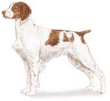|
Background on the Breed
Brittanys are
known as - Brittanys in the USA, l'Epagneul Breton in its homeland
of France & Brittany Spaniel in Canada. Not much is known of where
the spaniel from Northern France originated. The Hunters wanted a dog to help them with a keen nose and a good retrieving instinct. So the French sportsman crossed their short no tailed Spaniel with the English Setters that the English Sportsman brought with them . The Setter being bred to the French Spaniel enhanced the nose of the Spaniel and the Staunchness on point. There is clear indication that they preferred the short to No Tail from the French Spaniel and the Orange / White and the Liver / White colours over the long tails and the black. The Short Tail was preferred as it was less likely to get torn up by the heavy cover of the bushes out hunting. So the story goes they would not let any long Tailed pups breed to try to breed out the Long tail Gene, up until about 1927 when they gave in and would let the Long Tail pups breed but the standard still called for the short tail. The first recorded Brittany being shown was in Paris in
1896. The first Brittanys were brought to North America in 1912. The
American Kennel Club recognized the breed in 1934 but did not approve
the Standard until March 1935. In the USA the word Spaniel was taken
of the end of its name in 1982. This is because the Brittany is a
pointing dog & not a flushing dog like the rest of the spaniels.
World War II
did alot of damage to the breed in France. They needed to build
up the numbers so they started to allow the black back in as an
acceptable colouration because of the much depleted gene pool over
there. It was felt in North America that our gene pool was
sufficiently rich that we didn't need to change our Breed Standard to
allow Black. So we stopped importing the French Brittany and we now
have the American Brittany. Some people are breeding from the France
imports but they are called French Brittanys and the two do not mix
breed. The French Brittany can not show in North America because of
the Black which is not of the approved standard.
 
Breed Standard for the Brittany
General Appearance
A compact, closely knit
dog of medium size, a leggy dog having the appearance, as well as the agility,
of a great ground coverer. Strong, vigorous, energetic
and quick of movement. Ruggedness, without clumsiness, is a
characteristic of the breed. He can be tailless or has a tail docked to
approximately four inches.
Size, Proportion, Substance
Height: 17 1/2 to 20 1/2 inches,
measured from the ground to the highest point of the shoulders. Any Brittany measuring under 17 1/2 inches or over 20 1/2 inches shall be
disqualified from dog show competition.
Weight: Should weigh between 30 and 40 pounds.
Proportion: So leggy is he that his height at the shoulders is the same
as the length of his body.
Body Length: Approximately the same as the height when measured at the
shoulders. Body length is measured from the point of the fore chest to the rear
of the rump. A long body should be heavily penalized.
Substance: Not too light in bone, yet never heavy-boned and cumbersome.
Head
Expression: Alert and eager, but with the soft
expression of a bird dog.
Eyes: Well set in head. Well protected from briars by a heavy,
expressive eyebrow. A prominent, full or pop eye should be heavily penalized.
It is a serious fault in a dog that must face briars. Skull well chiseled under
the eyes, so that the lower lid is not pulled back to form a pocket or haw that
would catch seeds, dirt and weed dust. Preference should be for the darker
colored eyes, though lighter shades of amber should not be penalized. Light and
mean-looking eyes should be heavily penalized.
Ears: Set high, above the level of the eyes. Short and
triangular, rather than pendulous, reaching about half the length of the
muzzle. Should lie flat and close to the head, with
the tip rounded very slightly. Ears well covered with dense, but
relatively short hair, and with little fringe.
Skull: Medium length, rounded, very slightly wedge-shaped, but evenly
made. Width, not quite as wide as the length and never so broad as to appear
coarse, or so narrow as to appear racy. Well defined
but gently sloping stop. Median line rather indistinct.
The occipital only apparent to the touch. Lateral
walls well rounded. The Brittany should never be
"apple-headed" and he should never have an indented stop.
Muzzle: Medium length, about two-thirds the length of the skull,
measuring the muzzle from the tip to the stop, and the skull from the occipital
to the stop. Muzzle should taper gradually in both horizontal and vertical
dimensions as it approaches the nostrils. Neither a Roman nose nor a dish-face
is desirable. Never broad, heavy or snippy.
Nose: Nostrils well open to permit deep breathing of air and adequate
scenting. Tight nostrils should be penalized. Never shiny.
Color: fawn, tan, shades of brown or deep pink. A black nose is a
disqualification. A two-tone or butterfly nose should be penalized.
Lips: Tight, the upper lip overlapping the lower
jaw just to cover the lower lip. Lips dry, so that feathers will not
stick. Drooling to be heavily penalized. Flaws to be penalized.
Bite: A true scissors bite. Overshot or undershot jaw to be heavily
penalized.
Neck, Top line, Body
Neck: Medium length. Free from throatiness, though not
a serious fault unless accompanied by dewlaps, strong without giving the
impression of being over-muscled. Well set into sloping shoulders. Never concave or ewe-necked.
Top line: Slight slope from the highest point of the shoulders to the
root of the tail.
Chest: Deep, reaching the level of the elbow. Neither
so wide nor so rounded as to disturb the placement of the shoulders and elbows.
Ribs well sprung. Adequate heart room provided by depth as
well as width. Narrow or slab-sided chests area fault.
Back: Short and straight. Never hollow, saddle, sway or roach backed. Slight drop from the hips to the root of the tail.
Flanks: Rounded. Fairly full. Not extremely
tucked up, or flabby and falling. Loins
short and strong. Distance from last rib to upper thigh short, about
three to four fingers widths. Narrow and weak loins are a fault. In motion, the
loin should not sway sideways, giving a zig-zag
motion to the back, wasting energy.
Tail: Tailless to approximately four inches, natural or docked. The tail not to be so long as to affect the over-all balance of the
dog. Set on high, actually an extension of the spine at about the same
level. Any tail substantially more than four inches shall be severely
penalized.
Forequarters
Shoulders: Shoulder blades should not protrude too
much, not too wide apart, with perhaps two thumbs' width between. Sloping and muscular. Blade and upper arm should form nearly
a ninety degree angle. Straight shoulders are a fault. At the shoulders the Brittany is slightly higher than
at the rump.
Front Legs: Viewed from the front, perpendicular, but not set too
wide. Elbows and feet turning neither in nor out.
Pasterns slightly sloped. Down in pasterns is a serious fault. Leg bones clean,
graceful, but not too fine. Extremely heavy bone is as much a fault as spindly
legs. One must look for substance and suppleness. Height at elbows should
approximately equal distance from elbow to withers.
Feet: Should be strong, proportionately smaller than the spaniels', with
close fitting, well arched toes and thick pads. The Brittany is "not up on his
toes." Toes not heavily feathered. Flat feet, splayed feet, paper feet,
etc., are to be heavily penalized. An ideal foot is halfway between the hare
and the cat foot. Dewclaws may be removed.
Hindquarters: Broad strong and muscular, with powerful thighs and well bent
stifles, giving the angulations necessary for powerful drive.
Hind Legs: Stifles well bent. The stifle should not be so angulated as
to place the hock joint far out
Feet: Same as front feet.
Coat: Dense, flat or wavy, never curly. Texture
neither wiry nor silky. Ears should carry little fringe. The front and
hind legs should have some feathering, but too little is definitely preferable
to too much. Dogs with long or profuse feathering or furnishings shall be so
severely penalized as to effectively eliminate them from competition.
Skin: Fine and fairly loose. A loose skin rolls with briars and sticks,
thus diminishing punctures or tearing. A skin so loose as to form pouches is
undesirable.
Color: Orange and white or liver and
white in either clear or roan patterns. Some ticking is desirable. The orange
or liver is found in the standard parti-color or
piebald patterns. Washed out colors are not desirable. Tri-colors are allowed
but not preferred. A tri-color is a liver and white dog with classic orange
markings on eyebrows, muzzle and cheeks, inside the ears and under the tail, freckles on the lower legs are orange. Anything
exceeding the limits of these marking shall be severely penalized. Black is a
disqualification.
Gait: When at a trot the Brittany's hind foot should step
into or beyond the print left by the front foot. Clean movement, coming and
going, is very important, but most important is side gait, which is smooth,
efficient and ground covering.
Temperament: A happy, alert dog, neither mean nor shy.
Disqualifications
Any Brittany
measuring under 17 1/2 inches or over 20 1/2 inches. Black
in the coat. A black nose.
The above
Standard was approved by the AKC on April
9, 1990 and went into effect May 29, 1990.
|










